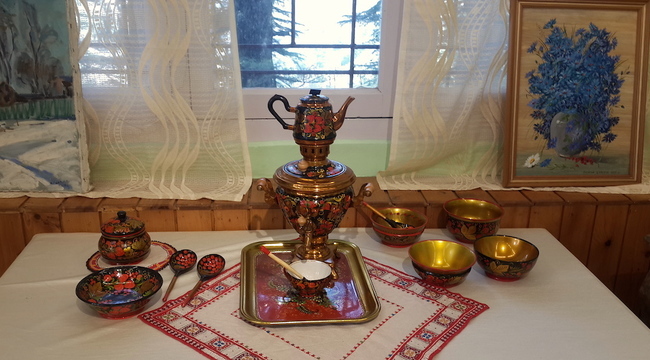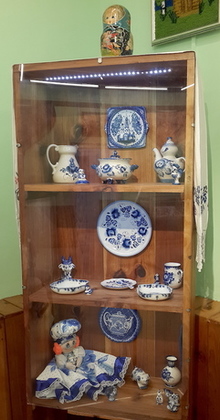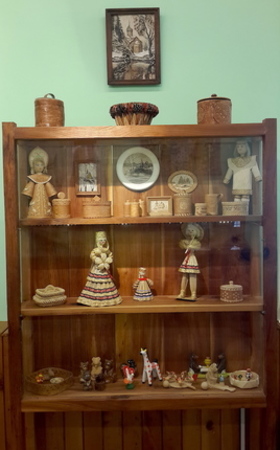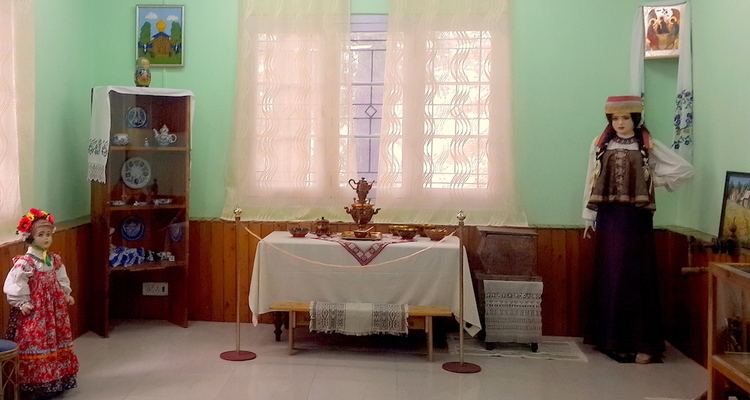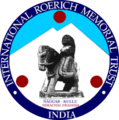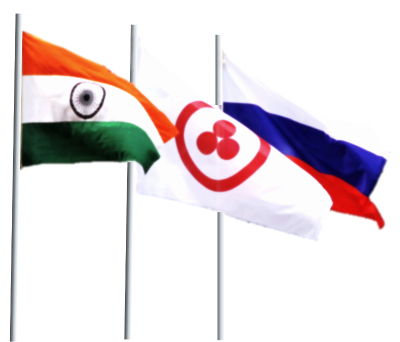Russian Decorative and Applied Arts Hall
The process of creating a collection of Russian Arts and Crafts objects in Himalayan Estate of the Roerichs started about the 60-s of the XX century when Svetoslav Roerich opened a gallery of Nicholas Roerich, his farther’s paintings in three rooms of the Roerichs House. We can imagine that guests from Russia, visited the Estate to see paintings of a great Russian artist, brought some Russian souvenirs: decorated plates and dishes, Russian toys, colorific trays, objects with Khokhloma painting and other things and presented them to Svetoslav Roerich and Devika Rani, who visited the Estate in Kullu every year. This tradition continued in the 1990-s when the International Roerich Memorial Trust was founded and the amount of guests from Russia became much larger. At that time the idea to introduce the Russian Decorative and Applied Arts to Indian tourists was created. The first exhibition of the Russian Folk Art was opened in the Administrative building of the Urusvati Institute at the beginning of the 2000-s and in 2017 in the Laboratory building of the Institute the renewed exposition was launched as thanks to help of friends from Russia the collection of the Russian arts and crafts in the IRMT is constantly enriched.
Folk craft is exactly what makes the Russian culture as well as culture of India and other countries rich and unique. Almost each part of Russia has its own kind of handicraft. From the earliest times wood painting and carving art, traditions of pottery and smithery, craftsmanship of clay and wood toys have been extant. Some kinds of traditional Russian crafts are presented at the exhibition of the Russian Hall.
Here you see a symbol of Russian tea party – painted metal samovar that was traditionally used in Russian families for boiling water and making tea. Usually the whole family was sitting around a samovar and everybody was drinking five or six cups of this full-flavored beverage.
Since the earliest times, artifacts of wood and metal have been emblazed in Russia. Technologies of emblazonment considerably varied in different regions of the country. For instance in XVII century an art of painting wood in golden color without using real gold was born in Khokhloma village of Nizhny Novgorod region. Khokhloma cups, spoons, dishes, colored with golden and multicolored inks were spread through all over Russia. Contemporary artifacts of Khokhloma art are displayed at the exhibition of the Russian Hall – a tea set on a table made of wood with painting in Russian style Khokhloma as if invites guests to a tea party.
Beauty and decorativeness are features of golden items of straw – dry scapes of different crops – you see them also in the display. Straw was a very important material in any farming household. Straw was used in thatching roofs of houses, cattle sheds, and storehouses. Cattle were fed up with straw. Straw was also a material for making images of deities. People with them met Sun-god in spring and saw off it in autumn. The deities were brought through villages with songs and then were burned or launched down a river on floats. Old rites have been long forgotten but a skill to create straw figures has survived to this day. Straw sculptures, toys, boxes and vases of warm gold color are popular among either children or adults.
From generation to generation the Russian craftsmen pass secrets of creating artifacts for home-using made of natural materials. Dishes, bast baskets, birchbark boxes that are presented in one of the Hall’s displays are real masterpieces. Artifacts made of birchbark – outer layer of birch skin – have always been very popular in Russia. Birchbark artifacts are famous for their lightness and ability to keep warm and they also have therapeutic value.
Guests can see the Trinity, a Russian icon in the corner on the wall shelf, dressed with embroidery towel. Such place in the Russian house with icons and a table was called the Red corner (meaning “beautiful”). Coming into the house a person firstly crossed themselves in front of the icon and only then greeted the hosts. The most honored guests were set in the Red corner. Any meal was started and finished with a prayer.
It is a nicely dressed “hostess” near the table inviting everybody to take photo with her.
One more famous kind of the Russian folk painting is Gzhel – the artifacts of that craft you can see in one of the displays in the Russian Hall. Here you see decorated vases, tea pots, plates and other pottery and china things, painted by hands with blue inks on white background. This art style appeared some centuries ago in Russian village named Gzhel and nowadays Gzhel masters carefully maintain and develop the ancient traditions.
Zhostovo craft was born in Zhostovo village outside Moscow in XIX century when local craftspeople started painting metal trays with bright flower bouquets on black or colored background. A usual tray became a piece of art. Those colored trays, made by contemporary Zhostovo masters are also displayed at the exhibition.
An art of making toys was born in Russia in ancient times. Russian folk toys are bright colored, have creative appearance and figurality. Each region made toys in its traditional form, colors, tracery and technic. The toys were made of wood, clay and fabric.
Colored Dymkovo toys – a symbol of Kirov region are presented at the exhibition. They were moulded out of clay then baked in kilns and painted by hands creating a unique piece of art.
Russian Matryoshka, painted wooden doll with a secret is well known in the world. The secret is the sisters of smaller size that appear when Matryoshka is open. Round-faced cheerful girls in heard scarfs usually hold reaping hook, jars with milk or baskets with berries. Beautiful designed Russian dolls enrich and vivify the museum space.
Special warmth and coziness of the Hall atmosphere come from Russian rag dolls made by craftswomen from different cities of Russia. Such dolls since ancient times have been made not only as kid toys but as amulets defending from bad fairies and bringing happiness.
You can see some elements of a traditional Russian costume decorated with embroidery at the exhibition. Also there are Pavlovo Posad shawls eye pleasing with bright colors and bast shoes made of bark. Such shoes were used in Russian villages since earlier ages till XX century. It is interesting to notice that such bast shoes just in combination with knitted inset have been traditional footwear in Himalayan regions of India including Kullu. Visitors of IRMT even today can wear them entering Art Gallery of Nicholas and Svetoslav Roerich’s paintings.
It has to be said that studying relations of Russian and Indian cultures was of special interest for Nicholas Roerich. Even being in Russia he got an idea about deep cultural affinity between Russia and India. “Long since we have been dreaming about principals of Indian art,” wrote the artist in 1913 in his article “Indian Way”. “Succession of our ancient daily life and art of India suggested itself.” Visitors of the Russian Hall will pay attention to similarity of traditions, technologies, ornaments of Russian handicrafts and Himalayan people’s art.
Beauty, significance, figurality of the craftsmen artifacts call to every understanding heart a wish to save and increase treasures of arts and crafts because craftwork is not only decoration or household items but kinds of national symbols that are inherited from generation to generation and make culture of every nation unique and unmatched.
